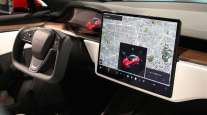Regulators Move to Rewrite Rules for Self-Driving Cars

The National Highway Traffic Safety Administration is considering eliminating regulations that currently block self-driving vehicles designed without steering wheels, brake pedals or other driver controls from hitting the road.
The agency, in a document posted online, said it will soon ask automakers and technology companies to identify “any unnecessary regulatory barriers to automated safety technologies.”
The move is an early signal that the Trump administration plans a formal effort to reshape auto safety regulations to accommodate self-driving vehicles. Companies including General Motors Co. and Alphabet Inc.’s Waymo are racing to develop self-driving car technologies that need no human intervention, which could one day lead to vehicles with radically different designs, such as lounge-like cabin configurations.
RELATED: ATA adopts automated truck policy
That’s currently impossible due to dozens of Federal Motor Vehicle Safety Standards. The first such standards date back the 1960s and many act as de facto requirements that automakers design cars, pickups trucks and SUVs for a human driver. One, for example, requires that vehicle brakes be operated by a driver’s foot.
The comments will be used by NHTSA to determine what changes are necessary to “safely lay a path for innovative automated vehicle designs and technology,” it said in a summary of rulemaking posted on the Transportation Department’s website.
In a statement, NHTSA said the move is part of the department’s efforts to “encourage innovation without reducing safety.”
NHTSA began working on the effort Sept. 20, roughly a week after the Transportation Department released updated voluntary safety guidance for self-driving vehicle developers. Safety groups criticized that guidance for being too easy on companies while autonomous vehicle developers praised it for giving them freedom to innovate.
RELATED: Self-driving big-rig technology moving quickly down the on-ramp
“Based on the guidelines that released, we have a pretty pessimistic view on how they view their regulatory role when it comes to autonomous vehicles,” said Peter Kurdock, director of regulatory affairs at Advocates for Highway and Auto Safety. “When they talk about regulatory barriers, we don’t see them as barriers, we see them as safeguards.”
Legislation in both chambers of Congress would allow developers to deploy tens of thousands of self-driving cars with designs that don’t comply with rules requiring a human driver under exemptions from NHTSA rules. Companies would be required to prove to the agency that the exempted vehicles are at least as safe as conventional vehicles.
Companies see the exemptions as a temporary solution to help get the vehicles in the field and gather more data to inform formal regulatory standards for the vehicles.
The House and Senate legislation would also direct NHTSA to amend regulations for self-driving vehicle safety standards, although the bills differ in their approach. The agency is now set to move ahead even before this legislation passes.




